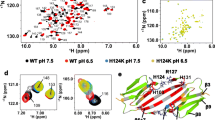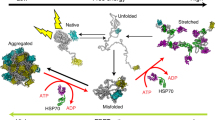Abstract
Heat shock protein A6, also known as HSP70B’, is a member of the Hsp70 family of molecular chaperones. Under stressed conditions, the level of HSPA6 increases substantially, and the protein has been targeted as a biomarker of cellular stress in several studies. We report the spectroscopic and thermodynamic properties of Arabian camel species cHSPA6, determined by measurement of intrinsic and extrinsic fluorescence emission, and use of far-UV circular dichroism and dynamic multimode spectroscopy. Our results showed that cHSPA6 has similar binding affinity for both ATP and ADP (K D = ~50 nM). Binding of ATP and ADP reduced the surface hydrophobicity of the protein, and slightly altered its secondary structure, suggesting localized conformational rearrangement after ATP or ADP binding. Dynamic multimode spectroscopy revealed that cHSPA6 unfolds through three transitions with melting points (T m) of 42.3 ± 0.2, 61.3 ± 0.1, and 81.2 ± 0.2 °C. To the best of the author’s knowledge, and literature search, this is the first report of the spectroscopic and thermodynamic properties of the Arabian camel heat shock protein.








Similar content being viewed by others
Abbreviations
- Amp:
-
Ampicillin
- DTT:
-
Dithiothreitol
- EDTA:
-
Ethylenediaminetetraacetic acid
- Em:
-
Emission
- Ex:
-
Excitation
- FPLC:
-
Fast protein liquid chromatography
- GdnHCl:
-
Guanidinium hydrochloride
- IPTG:
-
Isopropyl β-D-1-thiogalactopyranoside
- K D :
-
Dissociation constant
- LB:
-
Luria–Bertani
- 2XLB:
-
Double strength Luria–Bertani
- NB:
-
Nutrient broth
- MWCO:
-
Molecular weight cut off
- Ni-NTA:
-
Nickel-nitrilotriacetic acid
- NBD:
-
Nucleotide binding domain
- OD600 :
-
Optical density at 600 nm
- PMSF:
-
Phenylmethylsulfonyl fluoride
- rpm:
-
Rotation per minute
- SBD:
-
Substrate binding domain
- TB:
-
Terrific broth
- T m :
-
Melting temperature
References
Banecki B, Zylicz M, Bertoli E, Tanfani F (1992) Structural and functional relationships in DnaK and DnaK756 heat-shock proteins from Escherichia coli. J Biol Chem 267:25051–25058
Beere HM, Wolf BB, Cain K, Mosser DD, Mahboubi A, Kuwana T, Tailor P, Morimoto RI, Cohen GM, Green DR (2000) Heat-shock protein 70 inhibits apoptosis by preventing recruitment of procaspase-9 to the Apaf-1 apoptosome. Nat Cell Biol 2:469–475
Benjamin IJ, McMillan DR (1998) Stress (heat shock) proteins: molecular chaperones in cardiovascular biology and disease. Circ Res 83:117–132
Bohm G, Muhr R, Jaenicke R (1992) Quantitative analysis of protein far UV circular dichroism spectra by neural networks. Protein Eng 5:191–195
Borges JC, Ramos CH (2005) Protein folding assisted by chaperones. Protein Pept Lett 12:257–261
Borges JC, Ramos CH (2006) Spectroscopic and thermodynamic measurements of nucleotide-induced changes in the human 70-kDa heat shock cognate protein. Arch Biochem Biophys 452:46–54
Borges JC, Fischer H, Craievich AF, Ramos CH (2005) Low resolution structural study of two human HSP40 chaperones in solution. DJA1 from subfamily A and DJB4 from subfamily B have different quaternary structures. J Biol Chem 280:13671–13681
Brown GC (1991) Total cell protein concentration as an evolutionary constraint on the metabolic control distribution in cells. J Theor Biol 153:195–203
Buchberger A, Theyssen H, Schroder H, McCarty JS, Virgallita G, Milkereit P, Reinstein J, Bukau B (1995) Nucleotide-induced conformational changes in the ATPase and substrate binding domains of the DnaK chaperone provide evidence for interdomain communication. J Biol Chem 270:16903–16910
Bukau B, Horwich AL (1998) The Hsp70 and Hsp60 chaperone machines. Cell 92:351–366
Cheetham ME, Caplan AJ (1998) Structure, function and evolution of DnaJ: conservation and adaptation of chaperone function. Cell Stress Chaperones 3:28–36
Deuerling E, Patzelt H, Vorderwulbecke S, Rauch T, Kramer G, Schaffitzel E, Mogk A, Schulze-Specking A, Langen H, Bukau B (2003) Trigger Factor and DnaK possess overlapping substrate pools and binding specificities. Mol Microbiol 47:1317–1328
Dill KA (1990) Dominant forces in protein folding. Biochemistry 29:7133–7155
Edelhoch H (1967) Spectroscopic determination of tryptophan and tyrosine in proteins. Biochemistry 6:1948–1954
Elrobh MS, Alanazi MS, Khan W, Abduljaleel Z, Al-Amri A, Bazzi MD (2011) Molecular cloning and characterization of cDNA encoding a putative stress-induced heat-shock protein from Camelus dromedarius. Int J Mol Sci 12:4214–4236
Fan CY, Lee S, Ren HY, Cyr DM (2004) Exchangeable chaperone modules contribute to specification of type I and type II Hsp40 cellular function. Mol Biol Cell 15:761–773
Flaherty KM, DeLuca-Flaherty C, McKay DB (1990) Three-dimensional structure of the ATPase fragment of a 70 K heat-shock cognate protein. Nature 346:623–628
Flynn GC, Chappell TG, Rothman JE (1989) Peptide binding and release by proteins implicated as catalysts of protein assembly. Science 245:385–390
Freeman BC, Myers MP, Schumacher R, Morimoto RI (1995) Identification of a regulatory motif in Hsp70 that affects ATPase activity, substrate binding and interaction with HDJ-1. EMBO J 14:2281–2292
Gao B, Greene L, Eisenberg E (1994) Characterization of nucleotide-free uncoating ATPase and its binding to ATP, ADP, and ATP analogues. Biochemistry 33:2048–2054
Gragerov A, Zeng L, Zhao X, Burkholder W, Gottesman ME (1994) Specificity of DnaK-peptide binding. J Mol Biol 235:848–854
Ha JH, McKay DB (1994) ATPase kinetics of recombinant bovine 70 kDa heat shock cognate protein and its amino-terminal ATPase domain. Biochemistry 33:14625–14635
Heldens L, Dirks RP, Hensen SM, Onnekink C, van Genesen ST, Rustenburg F, Lubsen NH (2010) Co-chaperones are limiting in a depleted chaperone network. Cell Mol Life Sci 67:4035–4048
Huang SP, Tsai MY, Tzou YM, Wu WG, Wang C (1993) Aspartyl residue 10 is essential for ATPase activity of rat hsc70. J Biol Chem 268:2063–2068
Klostermeier D, Seidel R, Reinstein J (1998) Functional properties of the molecular chaperone DnaK from Thermus thermophilus. J Mol Biol 279:841–853
Leung TK, Rajendran MY, Monfries C, Hall C, Lim L (1990) The human heat-shock protein family. Expression of a novel heat-inducible HSP70 (HSP70B’) and isolation of its cDNA and genomic DNA. Biochem J 267:125–132
Liu C, Young AL, Starling-Windhof A, Bracher A, Saschenbrecker S, Rao BV, Rao KV, Berninghausen O, Mielke T, Hartl FU, Beckmann R, Hayer-Hartl M (2010) Coupled chaperone action in folding and assembly of hexadecameric Rubisco. Nature 463:197–202
Mayer MP, Bukau B (2005) Hsp70 chaperones: cellular functions and molecular mechanism. Cell Mol Life Sci 62:670–684
Mayer MP, Brehmer D, Gassler CS, Bukau B (2001) Hsp70 chaperone machines. Adv Protein Chem 59:1–44
Moffatt BA, Studier FW (1987) T7 lysozyme inhibits transcription by T7 RNA polymerase. Cell 49:221–227
Montgomery DL, Morimoto RI, Gierasch LM (1999) Mutations in the substrate binding domain of the Escherichia coli 70 kDa molecular chaperone, DnaK, which alter substrate affinity or interdomain coupling. J Mol Biol 286:915–932
Morano KA (2007) New tricks for an old dog: the evolving world of Hsp70. Ann N Y Acad Sci 1113:1–14
Moro F, Fernandez V, Muga A (2003) Interdomain interaction through helices A and B of DnaK peptide binding domain. FEBS Lett 533:119–123
Moro F, Fernandez-Saiz V, Muga A (2006) The allosteric transition in DnaK probed by infrared difference spectroscopy. Concerted ATP-induced rearrangement of the substrate binding domain. Protein Sci 15:223–233
Nishikawa M, Takemoto S, Takakura Y (2008) Heat shock protein derivatives for delivery of antigens to antigen presenting cells. Int J Pharm 354:23–27
Palleros DR, Welch WJ, Fink AL (1991) Interaction of hsp70 with unfolded proteins: effects of temperature and nucleotides on the kinetics of binding. Proc Natl Acad Sci USA 88:5719–5723
Palleros DR, Reid KL, Shi L, Welch WJ, Fink AL (1993) ATP-induced protein-Hsp70 complex dissociation requires K + but not ATP hydrolysis. Nature 365:664–666
Parsian AJ, Sheren JE, Tao TY, Goswami PC, Malyapa R, Van Rheeden R, Watson MS, Hunt CR (2000) The human Hsp70B gene at the HSPA7 locus of chromosome 1 is transcribed but non-functional. Biochim Biophys Acta 1494:201–205
Prendergast FG, Hampton PD, Jones B (1984) Characteristics of tyrosinate fluorescence emission in alpha- and beta-purothionins. Biochemistry 23:6690–6697
Rao MV, Atreyi M, Rajeswari MR (1981) Fluorescence spectra of lysozyme excited at 305 NM in presence of urea. Int J Pept Protein Res 17:205–210
Revington M, Zhang Y, Yip GN, Kurochkin AV, Zuiderweg ER (2005) NMR investigations of allosteric processes in a two-domain Thermus thermophilus Hsp70 molecular chaperone. J Mol Biol 349:163–183
Rist W, Graf C, Bukau B, Mayer MP (2006) Amide hydrogen exchange reveals conformational changes in hsp70 chaperones important for allosteric regulation. J Biol Chem 281:16493–16501
Roy A, Kucukural A, Zhang Y (2010) I-TASSER: a unified platform for automated protein structure and function prediction. Nat Protoc 5:725–738
Ruan K, Li J, Liang R, Xu C, Yu Y, Lange R, Balny C (2002) A rare protein fluorescence behavior where the emission is dominated by tyrosine: case of the 33-kDa protein from spinach photosystem II. Biochem Biophys Res Commun 293:593–597
Russell R, Jordan R, McMacken R (1998) Kinetic characterization of the ATPase cycle of the DnaK molecular chaperone. Biochemistry 37:596–607
Santoro MG (2000) Heat shock factors and the control of the stress response. Biochem Pharmacol 59:55–63
Schonfeld HJ, Behlke J (1998) Molecular chaperones and their interactions investigated by analytical ultracentrifugation and other methodologies. Methods Enzymol 290:269–296
Swain JF, Dinler G, Sivendran R, Montgomery DL, Stotz M, Gierasch LM (2007) Hsp70 chaperone ligands control domain association via an allosteric mechanism mediated by the interdomain linker. Mol Cell 26:27–39
Tavaria M, Gabriele T, Kola I, Anderson RL (1996) A hitchhiker’s guide to the human Hsp70 family. Cell Stress Chaperones 1:23–28
Teale FW (1960) The ultraviolet fluorescence of proteins in neutral solution. Biochem J 76:381–388
Theyssen H, Schuster HP, Packschies L, Bukau B, Reinstein J (1996) The second step of ATP binding to DnaK induces peptide release. J Mol Biol 263:657–670
Vogel M, Bukau B, Mayer MP (2006) Allosteric regulation of Hsp70 chaperones by a proline switch. Mol Cell 21:359–367
Vogt G, Woell S, Argos P (1997) Protein thermal stability, hydrogen bonds, and ion pairs. J Mol Biol 269:631–643
Wada K, Taniguchi A, Xu L, Okano T (2005) Rapid and highly sensitive detection of cadmium chloride induced cytotoxicity using the HSP70B’ promoter in live cells. Biotechnol Bioeng 92:410–415
Walmsley AR, Martin GE, Henderson PJ (1994) 8-Anilino-1-naphthalenesulfonate is a fluorescent probe of conformational changes in the D-galactose-H+ symport protein of Escherichia coli. J Biol Chem 269:17009–17019
Walter S, Buchner J (2002) Molecular chaperones–cellular machines for protein folding. Angew Chem Int Ed Engl 41:1098–1113
Wang XY, Li Y, Yang G, Subjeck JR (2005) Current ideas about applications of heat shock proteins in vaccine design and immunotherapy. Int J Hyperth 21:717–722
Wegele H, Muller L, Buchner J (2004) Hsp70 and Hsp90–a relay team for protein folding. Rev Physiol Biochem Pharmacol 151:1–44
Wu B, Hunt C, Morimoto R (1985) Structure and expression of the human gene encoding major heat shock protein HSP70. Mol Cell Biol 5:330–341
Wu SJ, Liu FH, Hu SM, Wang C (2001) Different combinations of the heat-shock cognate protein 70 (hsc70) C-terminal functional groups are utilized to interact with distinct tetratricopeptide repeat-containing proteins. Biochem J 359:419–426
Zylicz M, King FW, Wawrzynow A (2001) Hsp70 interactions with the p53 tumour suppressor protein. EMBO J 20:4634–4638
Acknowledgments
The authors extend their appreciation to King Abdulaziz City for Science and Technology (KACST), Riyadh, Saudi Arabia, for funding this work through project # A-C-11-0606.
Author information
Authors and Affiliations
Corresponding author
Rights and permissions
About this article
Cite this article
Malik, A., Haroon, A., Jagirdar, H. et al. Spectroscopic and thermodynamic properties of recombinant heat shock protein A6 from Camelus dromedarius . Eur Biophys J 44, 17–26 (2015). https://doi.org/10.1007/s00249-014-0997-2
Received:
Revised:
Accepted:
Published:
Issue Date:
DOI: https://doi.org/10.1007/s00249-014-0997-2




